- Home
- Oliver Sacks
The Mind's Eye Page 3
The Mind's Eye Read online
Page 3
Yet, in my office, she immediately recognized a picture of herself on a CD cover, playing Chopin. “It looks slightly familiar,” she said with a smile.
I asked her what she saw on a certain wall of my office. First, she turned her chair not to the wall but to the window, and said, “I see buildings.” Then I rotated her chair for her until she faced the wall. I had to take her through it bit by bit. “Do you see lights?” Yes, there, and there. It took a little while to establish that she was looking at a sofa beneath the lights, though its color was commented on at once. She observed something green lying on the sofa, and astonished me by saying, correctly, that it was a stretch cord. She said she had been given such a cord by her physiotherapist. Asked what she saw above the couch (a painting with abstract geometric forms), she said, “I see yellow … and black.” What is it? I asked. Something to do with the ceiling, Lilian hazarded. Or a fan. A clock. Then she added, “I haven’t really found out whether it is one item or many.” It was in fact a painting done by another patient, a colorblind painter. But clearly Lilian had no idea that it was a painting, was not even sure that it was a single object, and thought that it might be part of the structure of the room.
I found all this puzzling. How was it that she could not clearly distinguish a striking painting from the wall itself, yet could instantly recognize a small photograph of herself on a CD? How could she identify a slender green stretch cord while failing to see, or recognize, the sofa it was on? And there had been innumerable such inconsistencies before.
I wondered how she could read the time, since she was wearing a wristwatch. She could not read the numbers, she said, but could judge the position of the hands. I then showed her, mischievously, a strange clock I have, in which the numbers are replaced by the symbols of elements (H, He, Li, Be, etc.). She did not perceive anything the matter with this, since for her the chemical abbreviations were no more or less unintelligible than numerals would have been.
We went out for a walk, I in a bright-colored hat for recognition. Lilian was bewildered by the objects in one shop window—but so was I. This was a Tibetan-handicrafts shop, but they could have been Martian handicrafts, given the exotic unfamiliarity of everything. The shop next to this one, curiously, she recognized at once, and mentioned having passed it on her way to my office. It was a clock shop, with dozens of clocks of different sizes and shapes. She told me later that her father had had a passion for clocks.
A padlock on the door of another store was a total puzzle, though Lilian thought it might be something “to open up … like a hydrant.” The moment she touched it, though, she knew what it was.
We stopped briefly for coffee; then I took her to my apartment, on the next block. I wanted her to try my grand piano, an 1894 Bechstein. Entering my apartment, she immediately identified the grandfather clock in the hall. (Dr. P., by contrast, had tried to shake hands with a grandfather clock.)
She sat at the piano and played a piece—a piece that I found puzzling, for it seemed familiar to me in a way, yet unfamiliar, too. Lilian explained that it was a Haydn quartet she had heard on the radio and been enchanted by a couple of years before and which she had longed to play herself. So she had arranged it for the piano, and had done so entirely in her head, overnight. She had occasionally arranged pieces for the piano before her alexia, using manuscript paper and the original score, but when this became impossible, she found that she could do it wholly by ear. She felt that her musical memory, her musical imagery, had become stronger, more tenacious, but also more flexible, so that she could hold the most complex music in her mind, then rearrange it and replay it mentally, in a way that would have been impossible before. Her continually strengthening powers of musical memory and imagery had become crucial to her, kept her going since the onset of her visual difficulties, nine years earlier.2
Lilian’s obvious confusion about what was what in my office, and in the little streets and shops around it, brought home to me how dependent she was on the familiar, the memorized; how anchored she was to her own apartment and her own neighborhood. In time, perhaps, if she were to visit a place frequently, she would gradually become more familiar with it, but this would be a hugely complex enterprise, demanding great patience and resourcefulness, a whole new system of categorization and memorization. It was clear to me, after this one visit of Lilian’s to my office, that in the future I should stick to house calls, visiting her in her own apartment, where she felt organized, in control, at home. Going out, for her, was becoming an increasingly surreal visual challenge, full of fantastic and sometimes frightening misperceptions.
Lilian wrote to me again in August of 2001, expressing growing concern. She said she hoped I might be able to come soon for a visit, and I suggested the following weekend.
She stood by her door to welcome me, knowing, as she did, my own (lifelong) defects of visual and topographic recognition, my confusion of left and right, and my inability to find my way around inside buildings. She welcomed me with great warmth, but also a touch of anxiety, which seemed to hover throughout the visit.
“Life is difficult,” she began, after she had seated me and given me a glass of seltzer. She had trouble finding the seltzer in her refrigerator, and, not seeing the bottle, which was “hidden” behind a jug of orange juice, she had taken to exploring the refrigerator by hand, groping for a bottle of the right shape. “It is not getting better.… The eyes are very bad.” (She knows, of course, that her eyes are fine, and that it is the visual parts of the brain that are declining—indeed, she realized this before anyone else—but she finds it easier, more natural, to refer to her “bad eyes.”) When I had gone shopping with her two years before, she had seemed to recognize almost everything she saw, or at least had it coded by shape and color and location, so that she hardly ever needed help. At that time, too, she moved infallibly about her kitchen, never losing anything, working efficiently. Today, she “lost” both the seltzer and the schmaltz herrings—a losing that entailed not only forgetting where she had put them but not recognizing them when she saw them. I observed that the kitchen was less organized than it had been before—and organization is crucial in her situation.
Lilian’s anomia, her problems with finding words, had increased, too. When I showed her some kitchen matches, she recognized them at once, visually, but could not say the word “match,” saying, instead, “That is to make fire.” The Sweet’n Low, similarly, she could not name, but identified as “Better Than Sugar.” She was well aware of these difficulties, and of her strategies for dealing with them. “When I can’t say something,” she explained, “I circumscribe.”
She said that although she had recently traveled to Ontario, to Colorado, and to Connecticut with her husband, she would not have been able to do this by herself, as she had only a few years before. She felt that she remained quite capable of looking after herself at home when Claude was away. Still, she said, “When I am alone, it is lousy. I’m not complaining—I’m describing.”
While Lilian was in the kitchen at one point, I asked Claude how he felt about these problems. He expressed sympathy and understanding, but added, “My impatience is provoked sometimes when I think that some of her weaknesses may be exaggerated. I’ll give you an example. I get puzzled, annoyed sometimes, because Lilian’s ‘blindness’ is sometimes ‘selective.’ Last Friday, she noticed that a painting was hung lopsidedly by a few millimeters. And sometimes she comments on people’s facial expressions in tiny photographs. She will touch a spoon and ask, ‘What is this?’ and then five minutes later look at a vase and say, ‘We have a similar one.’ I have found no pattern, only inconsistency. What should my attitude be when she grabs a cup and says, ‘What’s this?’ I sometimes don’t tell her. But this may be wrong, and the effect disastrous. What should I say?”
This was, indeed, a very delicate matter. How much should he intervene when she was faced with perceptual bewilderment? How much should we prompt a friend or a patient when he has forgotten someone’s name? How
much do I myself—with no sense of direction—wish to be saved from blundering off in the wrong direction or left to battle out the right way by myself? How much do any of us like to be “told” anything? The question was especially vexing with Lilian, for, while she needed to work things out, fend for herself, her visual difficulties were becoming more severe all the time, and they sometimes threatened, as Claude observed, to throw her into a panic of disorientation. I could suggest no rule, I said to Claude, except that of tact: each situation would call for its own solution.
But I, too, was puzzled by the extraordinary variations in Lilian’s visual function. Some of them, it seemed, went with the reduced and unstable function of her damaged visual cortex—just as, ten years earlier, when the first problems appeared, her ability to read music would come and go. Some of the variations, I thought, might reflect fluctuations in blood flow. But some of the variations seemed to go with a decreasing ability, for whatever reason, to compensate in her usual way. Her ability to make use of her memory and her intellectual powers in place of direct visual recognition, I now felt, might also be diminishing at this point. Thus it was more important than ever for Lilian to “code” things, to provide easily used sensory clues—above all, color, to which she remained intensely sensitive.
What intrigued me especially was Claude’s mention of Lilian’s sudden abilities—her ability, for example, to perceive facial expressions on a tiny photograph, even though most of the time she had difficulty recognizing people at all. I could not help wondering whether this was an example of the preconscious abilities she had shown on earlier testing—as when she could categorize words, even though she could not recognize the objects they represented, as “living” or “nonliving.” Such unconscious recognition might be possible to some extent despite her agnosia, despite her cortical damage, because it made use of other, still intact mechanisms in the visual system.
An extraordinary firsthand account of “musical alexia with recovery” was published by Ian McDonald in 2006. It was the first such personal account to be published, and was doubly remarkable because McDonald himself was both a neurologist and a fine amateur musician. His musical alexia (along with other problems, including difficulties with calculation, face-blindness, and topographic disorientation) was caused by an embolic stroke, and he was to make a complete recovery.3 He stressed that, even though there was gradual improvement in his ability to read music, especially associated with practice, his musical alexia fluctuated considerably from day to day.
Lilian’s physicians initially thought that she, too, had had a stroke and that the variations in her abilities might go with this. But such fluctuations are typical of any neural system that has sustained damage, irrespective of the cause. Patients with sciatica from nerve-root compression have good and bad days, as do patients with impairments of sight or hearing. There is less reserve, less redundancy, when a system is damaged, and it is more easily thrown off by adventitious factors such as fatigue, stress, medications, or infections. Such damaged systems are also prone to spontaneous fluctuations, as my Awakenings patients experienced constantly.
Lilian had been ingenious and resilient in the eleven or twelve years since her illness started. She had brought inner resources of every kind to her own aid: visual, musical, emotional, intellectual. Her family, her friends, her husband and daughter, above all, but also her students and colleagues, helpful people in the supermarket or on the street—everyone had helped her cope. Her adaptations to the agnosia were extraordinary—a lesson in what could be done to hold together a life in the face of ever-advancing perceptual and cognitive challenge. But it was in her art, her music, that Lilian not only coped with disease but transcended it. This was clear when she played the piano, an art that both demands and provides a sort of superintegration, a total integration of sense and muscle, of body and mind, of memory and fantasy, of intellect and emotion, of one’s whole self, of being alive. Her musical powers, mercifully, remained untouched by her disease.
Her piano playing always added a transcendent note to my visits, and it recalled her, no less crucially, to her identity as an artist. It showed the joy she could still get and give, whatever other problems were now closing in on her.
When I revisited Lilian and Claude in 2002, I found the apartment full of balloons. “It was my birthday, three days ago,” Lilian explained. She did not look well and seemed somewhat frail, although her voice and her warmth were entirely unchanged. She said that her visual powers had deteriorated further, and this was all too evident as she groped for a chair to sit down on, walked in the wrong direction, and got lost inside her own apartment. Her behavior now looked much more “blind,” reflecting not only her increasing inability to decipher what faced her but a complete lack of visual orientation.
She was still able to write letters, but reading, even the painfully slow letter-by-letter reading that she could do a few years before, had become impossible. She adored being read to—Claude would read to her from newspapers and books—and I promised to send her some audiotapes. She could still go out a little, walking around the block on her husband’s arm. The two of them were closer than ever, with her increasing disability.
Despite all this, Lilian felt that her ear was as good as it always was, and she had been able to continue a little teaching, with students from the music college coming to her apartment. Apart from this, though, she no longer played the piano much.
And yet, when I mentioned the Haydn quartet she had played for me before, her face lit up. “I was absolutely enthralled by that piece,” she said. “I’d never heard it before. It’s very rarely played.” And she described for me again how, unable to get it out of her head, she had arranged it, mentally, for the piano, overnight. I asked her to play it for me again. Lilian demurred, and then, persuaded, started for the piano, but went in the wrong direction. Claude corrected her gently. At the piano, she first blundered, hitting wrong notes, and seemed anxious and confused. “Where am I?” she cried, and my heart sank. But then she found her place and began to play beautifully, the sound soaring up, melting, twisting into itself. Claude was amazed and moved by this. “She hasn’t played at all for two or three weeks,” he whispered to me. As she played, Lilian stared upward, singing the melody softly to herself. She played with consummate artistry, with all the power and feeling she had shown before, as Haydn’s music swelled into a furious turbulence, a musical altercation. Then, as the quartet drew to its final, resolving chords, she said, simply, “All is forgiven.”
1. I saw Dr. P. in 1978, ten years before Benson and his colleagues described PCA. I was puzzled by the picture Dr. P. presented, the paradoxes of his illness. Clearly, he had a degenerative brain disease, yet it seemed quite different from any form of Alzheimer’s disease I had seen. But if not Alzheimer’s, then what did he have? When I read about PCA in 1988—Dr. P. had died in the meantime—I wondered whether this could have been his diagnosis.
PCA, however, is only an anatomical diagnosis; it denotes the part of the brain affected most but says nothing of the underlying disease process, nothing of why these parts of the brain are damaged.
When Benson described PCA, he had no information regarding its underlying pathology. His patients might have Alzheimer’s disease, he thought, but if so, it was Alzheimer’s with a strikingly atypical presentation. They might have Pick’s disease, a degenerative brain disorder more commonly affecting the frontal and temporal lobes of the brain. They might even, Benson speculated, have vascular rather than degenerative disease, an accumulation of small blockages in the watershed zone between the posterior and carotid circulations of the brain.
2. I was reminded, when Lilian told me this, of a patient I had seen in the hospital some years before, who had overnight become totally paralyzed from a spinal cord infection, a fulminating myelitis. When it became evident that no recovery was forthcoming, she fell into despair, felt that her life was over—not only the great things of life but the little familiar pleasures of each day,
like doing the New York Times crossword, to which she was addicted. She requested that the Times be brought to her each day, so that at least she could look at the puzzle, get its configuration, run her eyes along the clues. But when she did this something extraordinary happened, for as she looked at the clues, the answers seemed to write themselves in their spaces. Her visual imagery strengthened over the next few weeks, until she found that she was able to hold the entire crossword and its clues in her mind after a single, intense inspection, and then solve it, mentally, at her leisure later in the day. This became a source of great solace to her, in her paralysis; she had had no idea, she later told me, that such powers of memory and imagery were available to her.
3. McDonald also lost, temporarily, the ability to play the piano accurately and expressively, a problem Lilian did not have.
Recalled to Life
PATRICIA H. was a brilliant and energetic woman who represented artists, ran an art gallery on Long Island, and was a talented amateur painter herself. She had raised her three children and, nearing sixty, continued to lead an active and even, as her daughters put it, “glamorous” life, with scouting expeditions to the Village and frequent soirées at home—she loved to cook, and there would often be twenty people for dinner. Her husband, too, was a man of many parts—a radio broadcaster, a fine pianist who sometimes performed at nightclubs, and politically active. Both were intensely sociable.

 Uncle Tungsten
Uncle Tungsten Oaxaca Journal
Oaxaca Journal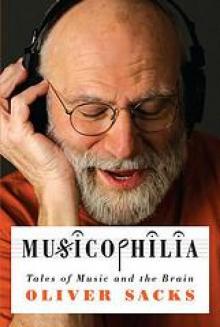 Musicophilia
Musicophilia The man who mistook his wife for a hat
The man who mistook his wife for a hat 1989 - Seeing Voices
1989 - Seeing Voices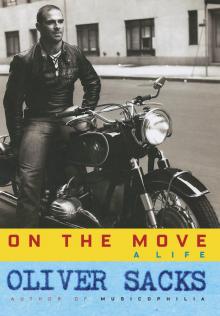 On the Move: A Life
On the Move: A Life 1996 - The Island of the Colorblind
1996 - The Island of the Colorblind An Anthropologist on Mars: Seven Paradoxical Tales
An Anthropologist on Mars: Seven Paradoxical Tales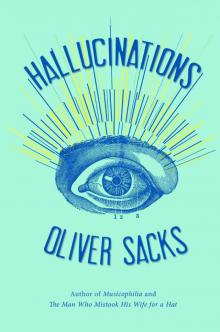 Hallucinations
Hallucinations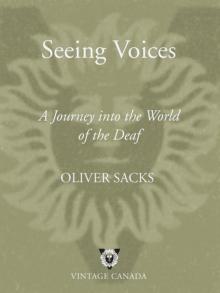 Seeing Voices
Seeing Voices The River of Consciousness
The River of Consciousness Vintage Sacks
Vintage Sacks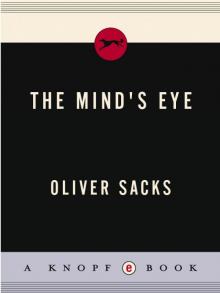 The Mind's Eye
The Mind's Eye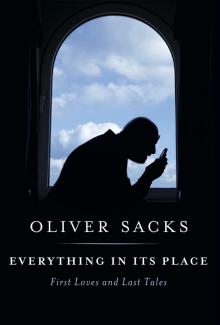 Everything in Its Place
Everything in Its Place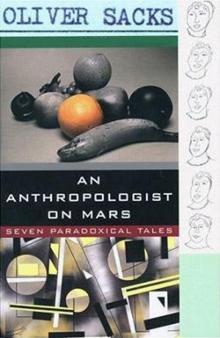 An Anthropologist on Mars (1995)
An Anthropologist on Mars (1995) Uncle Tungsten: Memories of a Chemical Boyhood (2001)
Uncle Tungsten: Memories of a Chemical Boyhood (2001)